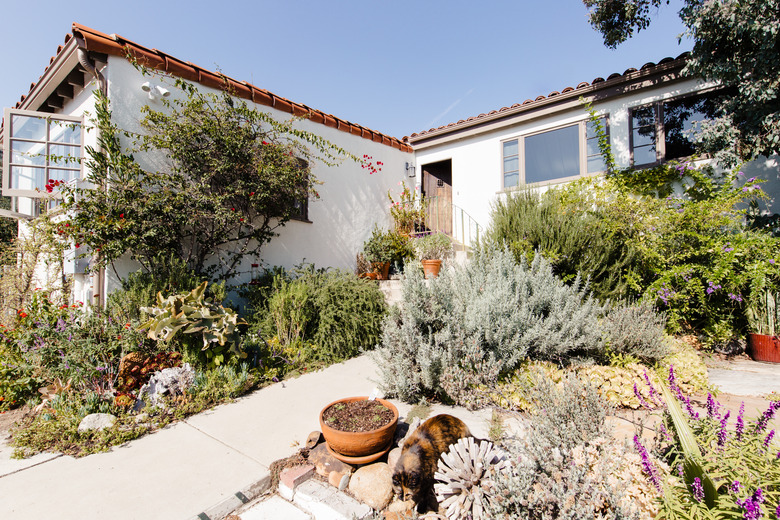The Real Way To Charm Hummingbirds Into Your Yard And Garden
It's no wonder we all want to attract hummingbirds into our yards. It's like magic watching them in action, flying sideways, straight up or down, and backward ... sometimes beating their wings 80 times per second when hovering over flowers or nectar. (!)
If you want to charm these fascinating fliers into visiting your yard or garden more regularly, putting up a feeder with liquid and sugar is a start. But you're more likely to draw hummingbirds on a regular basis if you plant salvia.
The Salvia genus includes species that bloom every month of the year, and offer a repository of nourishment in summer or winter. Blooming salvia plants along a migration route can make the difference between life and death for a hummingbird.
Which Salvia to Plant
Which Salvia to Plant
Hummingbird experts recommend that you install salvia plants in your garden as magnets for hummingbirds. Here is a list of their top 10 recommendations.
1. Pineapple Sage (Salvia elegans)
All salvia are pretty easy to grow, but pineapple sage is especially simple. Set out a small plant in spring after the frosts, it will transform into a plant some 4 feet tall and wide by midsummer, when the spires of lipstick-red blossoms feed migrating hummers. It is a tough plant, cold hardy to -20 degrees Fahrenheit. Wondering about the common name? Just rub a leaf and sniff.
2. Black-Currant Sage (Salvia microphylla)
These salvias are also known as "hot lips" for their red and white blossoms. The species grows profusely in the wild in Arizona, but they will jump at the chance to grow anywhere in zones 8 through 10 where they remain blooming almost year round. And they are entirely lovely, with graceful, arching reddish stems.
3. Hummingbird Sage (Salvia spathacea)
The common name says it all: This California native perennial feeds the overwintering hummingbird population winter through spring followed by a second bloom in autumn. Its brilliant magenta flowers group along stems to 3 feet tall together with aromatic hairy leaves, very soft to the touch.
*4. Cleveland Sage (Salvia clevelandii) *
Experts call this native shrub the easiest native salvia to grow, which is saying a lot given the ease with which most sage transplants. This shrub is native to Southern California, where it grows to 5 feet tall and wide, with flowering spikes topping the foliage during summer. The spikes hold several whorls of violet blooms, beloved by hummingbirds. Plant in full sun, and feel free to prune them down to a size that works for your garden.
*5. Anise-Scented Sage (Salvia guaranitica) *
Here's an interesting salvia, a showy perennial with foliage scented like anise. More to the point, as far as nectar goes, this salvia has long spires of large, deep-purple flowers from midsummer to frost. Expect a dense shrub, some 6 feet tall and 2 feet wide, drought tolerant, and attractive to hummers and butterflies.
6. Mexican Bush Sage (Salvia Leucantha)
Is this the most attractive salvia out there? Many gardeners adore it for its showy, velvety blossom spikes with bicolor flowers, soft-purple sepals contrasting nicely with fuzzy white flowers. They grow on gracefully arching stems until the first frost. In frost-free areas (like San Francisco), they bloom almost year round.
7. Autumn Sage (Salvia greggii)
Easy care? Thrives on neglect? Drought tolerant? Most salvia species qualify, including autumn sage, a native plant that blooms constantly from early spring through early winter. The species grows cardinal-red trumpet-shaped flowers, but this evergreen shrub has many cultivars with a variety of bloom colors.
*8. Purple Sage (Salvia leucophylla) *
This salvia forms thick, dense bushes of gray-green foliage in the wild in Southern California mountains, up to 5 feet high. The large spikes of flowers are purple and very lovely, growing from early spring through summer. Grow this salvia in zones 7 to 10 where it is extremely drought tolerant.
9. Royal Sage (Salvia regla)
The huge, flame-red blossoms of this native Texas sage pull the hummers right out of the skies as they migrate in early summer. Then, in fall as the birds are passing south, royal sage blooms once again, offering nectar for return trip energy. It is both cold tolerant and easy to propagate from cuttings.
10. Forsythia Sage (Salvia madrensis)
In a hurry to plant salvia and get nectar to those hummers? Try forsythia sage, a quick-growing Mexican native that can soar to 7 feet high in one season. The leaves are an attractive green and quite large, and the long, long spikes of brilliant canary-yellow blossoms attract hummers from late summer through fall and into winter in zones 7 to 11.
